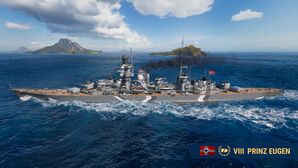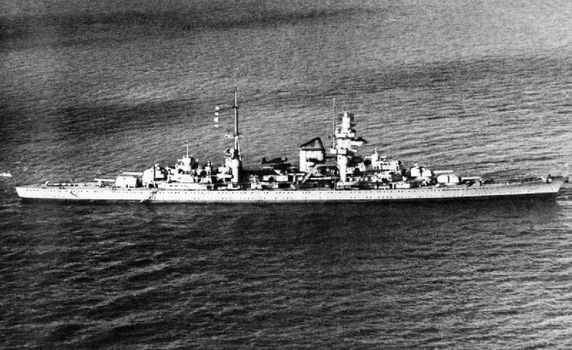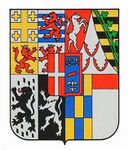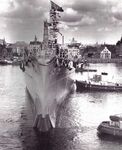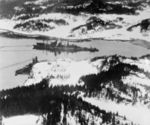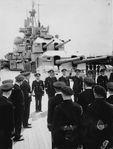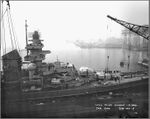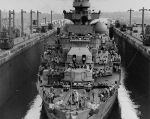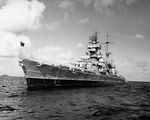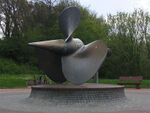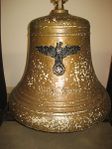Prinz Eugen
| Revision as of 15:37, 23 July 2018 inaccuracies | Revision as of 16:30, 17 October 2018 | |||
| Line 199: | Line 199: | |||
| ===History=== | ===History=== | |||
| ====Design==== | ====Design==== | |||
| ? | The third ship in the ''[[Admiral Hipper]]'' class, the design for ''Prinz Eugen'' began under the limitations of the Treaty of Versailles. Because Germany was forbidden from constructing heavy cruisers under the limitations of the treaty, the actual building of such ships was — in the early 1930s — politically undesirable. Planning was, however, impossible to prevent, and a design commission was authorized. In June 1935, the Anglo-German Naval Treaty was signed and Germany was authorized to build ships within a 35:100 tonnage ratio to Britain, though Germany was still to remain under the restrictions enforced by the Treaty of Versailles. At the time, Royal Navy possessed total cruiser displacement of 146,800 tons, which provided the Germans an allotment of 51,380 tons for cruisers of their own. The justification for the ''Admiral Hipper'' class was to be found under the terms of the First London Naval Treaty which limited cruiser displacement to roughly 10,000 tons per ship for all signatory nations. Though Germany was not a signatory to the First London Naval Treaty, the restrictions under Versailles made the construction of heavy cruisers politically dangerous for Germany and cruisers over 10,000 tons even more so, thus construction of the planned five cruisers of the ''Admiral Hipper'' class was begun in secret until the abrogation of the Treaty of Versailles removed that necessity. | + | The third ship in the ''[[Admiral Hipper]]'' class, the design for ''Prinz Eugen'' began under the limitations of the Treaty of Versailles. Because Germany was forbidden from constructing heavy cruisers under the limitations of the treaty, the actual building of such ships was — in the early 1930s — politically undesirable. Planning was, however, impossible to prevent, and a design commission was authorized. In June 1935, the Anglo-German Naval Treaty was signed and Germany was authorized to build ships within a 35:100 tonnage ratio to Britain, though Germany was still to remain under the restrictions enforced by the Treaty of Versailles. At the time, Royal Navy possessed a total cruiser displacement of 146,800 tons, which provided the Germans an allotment of 51,380 tons for cruisers of their own. The justification for the ''Admiral Hipper'' class was to be found under the terms of the First London Naval Treaty, which limited cruiser displacement to roughly 10,000 tons per ship for all signatory nations. Though Germany was not a signatory to the First London Naval Treaty, the restrictions under Versailles made the construction of heavy cruisers politically dangerous for Germany (and cruisers over 10,000 tons even more so), thus construction of the planned five cruisers of the ''Admiral Hipper'' class was begun in secret until the abrogation of the Treaty of Versailles removed that necessity. | |
| ? | The design requirements for the ''Admiral Hipper'' class required the ships to be comparable to the French ''[[Algérie]]'' class, faster than the ''[[Dunkerque]]'' class, and capable of long range operations in the Atlantic Ocean while still within 10,000 | + | The design requirements for the ''Admiral Hipper'' class required the ships to be comparable to the French ''[[Algérie]]'' class, faster than the ''[[Dunkerque]]''-class battleships, and capable of long range operations in the Atlantic Ocean while still within the 10,000-ton limit. While smaller, less politically dangerous designs with diesel or turbo-electric propulsion and 150mm to 190mm guns were initially considered, the final design settled on high pressure steam propulsion and 203mm guns. While the officially stated displacement would be 10,000 tons, the actual design displacement of the ''Admiral Hipper'' class would exceed 14,000 tons. | |
| Having settled the specifics of the design, the first two ships of the class, ''Admiral Hipper'' and ''Blücher'', were laid down in 1934 and 1935 respectively. ''Prinz Eugen'' was authorized in late 1935 along with two more ships, and laid down in the spring of the following year. Her construction started on 23 April 1936 in the Krupp-Germania Shipyards in Kiel. A slight difference in blueprints sent to dockyards resulted in a shorter hull of 205.9 m compared to 212.5 m of her sister-ships. | Having settled the specifics of the design, the first two ships of the class, ''Admiral Hipper'' and ''Blücher'', were laid down in 1934 and 1935 respectively. ''Prinz Eugen'' was authorized in late 1935 along with two more ships, and laid down in the spring of the following year. Her construction started on 23 April 1936 in the Krupp-Germania Shipyards in Kiel. A slight difference in blueprints sent to dockyards resulted in a shorter hull of 205.9 m compared to 212.5 m of her sister-ships. | |||
| Line 207: | Line 207: | |||
| ''Prinz Eugen'' received the benefit of experience in the construction and trials of her preceding sisters, and was completed with minor differences. At her launch on 22 August 1938, ''Prinz Eugen'' still featured a straight bow with triple anchors and open funnels. Before commissioning, she was drydocked to refit a clipper bow and capped funnels. She also possessed a rectangular bridge, larger hangar, and the two radar sets which became typical of the class. In a notable difference between ''Prinz Eugen'' and her preceding sisters, ''Prinz Eugen'' was also completed with her forward high angle directors exposed, the spherical covers being fitted a year later. Because of the incremental alterations to her basic design, ''Prinz Eugen'' measured 5 meters longer, 0.6 meter wider, 0.2 m deeper in draft and 200 tons heavier than ''Admiral Hipper'', while her standard displacement exceeded that of ''Admiral Hipper'' by 1,800 tons. | ''Prinz Eugen'' received the benefit of experience in the construction and trials of her preceding sisters, and was completed with minor differences. At her launch on 22 August 1938, ''Prinz Eugen'' still featured a straight bow with triple anchors and open funnels. Before commissioning, she was drydocked to refit a clipper bow and capped funnels. She also possessed a rectangular bridge, larger hangar, and the two radar sets which became typical of the class. In a notable difference between ''Prinz Eugen'' and her preceding sisters, ''Prinz Eugen'' was also completed with her forward high angle directors exposed, the spherical covers being fitted a year later. Because of the incremental alterations to her basic design, ''Prinz Eugen'' measured 5 meters longer, 0.6 meter wider, 0.2 m deeper in draft and 200 tons heavier than ''Admiral Hipper'', while her standard displacement exceeded that of ''Admiral Hipper'' by 1,800 tons. | |||
| ? | Because German capital ships generally followed similar design characteristics and arrangement of tower mast and funnels, they possessed a very similar appearance. The similarities between the ''Admiral Hipper''-class cruisers and ''Bismarck''-class battleships could | + | Because German capital ships generally followed similar design characteristics and arrangement of tower mast and funnels, they possessed a very similar appearance. The similarities between the ''Admiral Hipper''-class cruisers and ''Bismarck''-class battleships could — and did — confuse observers in poor visibility and without scale reference. On 24 May 1941, during the Battle of the Denmark Strait, Admiral Holland aboard HMS ''[[Hood]]'' made just such an error, mistaking ''Prinz Eugen'' for the battleship ''[[Bismarck]]''. | |
| ''Prinz Eugen'' was to receive multiple anti-aircraft modifications throughout her career, with new 20mm batteries being placed on the roofs of her "Bruno" and "Caesar" turrets, as well as replacing landed searchlights (both forward and astride the funnel). Later plans to further augment her anti-aircraft complement with additional 20mm and 40mm guns were at least partially completed by the end of World War II. | ''Prinz Eugen'' was to receive multiple anti-aircraft modifications throughout her career, with new 20mm batteries being placed on the roofs of her "Bruno" and "Caesar" turrets, as well as replacing landed searchlights (both forward and astride the funnel). Later plans to further augment her anti-aircraft complement with additional 20mm and 40mm guns were at least partially completed by the end of World War II. | |||
| ? | ''Prinz Eugen'' | + | Over time, ''Prinz Eugen'' became one of the most heavily sensor-equipped ships in German Navy. Throughout her career, multiple models of radars were equipped and replaced. These included: a FuMO 27 fitted at aft fire director in 1940; a FuMO 27 fitted at foretop in 1940, which was subsequently replaced by a FuMO 26 in 1942; a FuMO 25 fitted at mainmast in 1944; and a FuMO 81 fitted at foremast in 1944. A FuMB 1 passive radar detector was also fitted in 1940, and was later augmented by the installation of FuMB 4, FuMB 9, and FuMB 26 in 1944. A passive hydrophone system was installed aboard ''Prinz Eugen'' in August 1940. The equipment allowed her crews to listen to the acoustic signatures emitted by other ships to a maximum distance of 27 km even at maximum speed, provided said ships were not obscured by her own acoustic shadow. | |
| ====Service==== | ====Service==== | |||
| ''Prinz Eugen'' saw combat before she was officially commissioned, when the Royal Air Force bombed the shipyard at Kiel on 1 July 1940 and caused minor damage to the ship itself. After undergoing repairs, ''Prinz Eugen'' was commissioned into the Kriegsmarine on 1 August 1940. The cruiser spent the remainder of 1940 and early 1941 conducting sea trials and gunnery training. Following the completion of her preliminary tasks, she was scheduled to accompany the newly commissioned battleship ''[[Bismarck]]'' on Operation Rheinübung; however, this was delayed after ''Prinz Eugen'' struck a mine on her voyage to Kiel. | ''Prinz Eugen'' saw combat before she was officially commissioned, when the Royal Air Force bombed the shipyard at Kiel on 1 July 1940 and caused minor damage to the ship itself. After undergoing repairs, ''Prinz Eugen'' was commissioned into the Kriegsmarine on 1 August 1940. The cruiser spent the remainder of 1940 and early 1941 conducting sea trials and gunnery training. Following the completion of her preliminary tasks, she was scheduled to accompany the newly commissioned battleship ''[[Bismarck]]'' on Operation Rheinübung; however, this was delayed after ''Prinz Eugen'' struck a mine on her voyage to Kiel. | |||
| ? | On 11 May 1941, with her repairs complete, ''Prinz Eugen'' set off into the Atlantic to rendezvous with ''Bismarck''. On 20 May, the Swedish cruiser ''Gotland'' located the German fleet and reported their whereabouts to the Royal Navy. After stopping in Bergen for fuel and to be painted in the standard Baltic camouflage, ''Prinz Eugen'' and ''Bismarck'' set course for the Denmark Strait. On 23 May, the British cruiser HMS ''Suffolk'' spotted the two German warships and along with HMS ''Norfolk'', shadowed them through the icy strait. ''Prinz Eugen'' was given the | + | On 11 May 1941, with her repairs complete, ''Prinz Eugen'' set off into the Atlantic to rendezvous with ''Bismarck''. On 20 May, the Swedish cruiser ''Gotland'' located the German fleet and reported their whereabouts to the Royal Navy. After stopping in Bergen for fuel and to be painted in the standard Baltic camouflage, ''Prinz Eugen'' and ''Bismarck'' set course for the Denmark Strait. On 23 May, the British cruiser HMS ''Suffolk'' spotted the two German warships and along with HMS ''Norfolk'', shadowed them through the icy strait. ''Prinz Eugen'' was given the order to fire at the HMS ''Suffolk'', but refrained due to the misty conditions which limited visibility. The following day, ''Bismarck'' and ''Prinz Eugen'' engaged the English warships HMS ''Prince of Wales'' and HMS ''[[Hood]]'' near the southwestern coast of Iceland. ''Prinz Eugen'' herself did not participate extensively in this engagement, choosing the stay behind ''Bismarck'' and monitor the shadowing cruisers. However, the cruiser was still able to land several hits on HMS ''Prince of Wales'' and is reported to have started a small fire on her deck. Following this short engagement, ''Prinz Eugen'' detached from ''Bismarck''’s formation to begin her commerce raid in the North Atlantic but was forced to retreat to Brest, France after suffering an engine failure. | |
| ? | While receiving repairs in Brest, ''Prinz Eugen'' was hit by a bomb during one of the Royal Air Force’s raid on the shipyard, destroying her main control room and further delaying her return to service. Following several more bombings from the Royal Air Force, the | + | While receiving repairs in Brest, ''Prinz Eugen'' was hit by a bomb during one of the Royal Air Force’s raid on the shipyard, destroying her main control room and further delaying her return to service. Following several more bombings from the Royal Air Force, the Kriegsmarine decided to relocate ''Prinz Eugen'' and the battleships ''[[Scharnhorst]]'' and ''[[Gneisenau]]'' through the English Channel and into safer shipyards. On the night of 11 February 1942, the three German vessels — accompanied by a flotilla of torpedo boats — embarked on their dangerous voyage through the English Channel. The German forces faced heavy fire from aircraft and coastal artillery units but managed to traverse the Channel with only minimal damage and arrived in Germany two nights later. | |
| On 21 February 1942, ''Prinz Eugen'' — accompanied by ''Admiral Scheer'' and several destroyers — departed from Germany on a voyage to Norway. While conducting patrol operations off the coast of Trondheimsfjorden, ''Prinz Eugen'' was torpedoed by the British submarine HMS ''Trident''. The torpedo hit caused extensive damage to the ship’s stern and completely disabled her rudder. ''Prinz Eugen'' was towed to Lofjord where she received emergency repairs before returning to Germany in May to complete the job. | On 21 February 1942, ''Prinz Eugen'' — accompanied by ''Admiral Scheer'' and several destroyers — departed from Germany on a voyage to Norway. While conducting patrol operations off the coast of Trondheimsfjorden, ''Prinz Eugen'' was torpedoed by the British submarine HMS ''Trident''. The torpedo hit caused extensive damage to the ship’s stern and completely disabled her rudder. ''Prinz Eugen'' was towed to Lofjord where she received emergency repairs before returning to Germany in May to complete the job. | |||
| ? | In January 1943, ''Prinz Eugen'' was assigned to the Fleet Training Squadron in the Baltic Sea; however, she returned to combat service in October to help counter the Russian offense on the Eastern Front. Together with sister ship ''Lützow'', ''Prinz Eugen'' spent the greater part of 1943 and 1944 providing coastal support during the German withdrawal from Finland and the attempted invasion of Hogland. The cruiser was again put out of service for repairs in October 1944 after ramming the ''[[Nürnberg]]''-class light cruiser ''Leipzig''. By January 1945, the ship returned to providing coastal support until ''Lützow''’s sinking on 16 April. Four days later, ''Prinz Eugen'' arrived in Copenhagen where, on 7 May, she was decommissioned and surrendered to the Royal Navy. | + | In January 1943, ''Prinz Eugen'' was assigned to the Fleet Training Squadron in the Baltic Sea; however, she returned to combat service in October to help counter the Russian offense on the Eastern Front. Together with sister ship ''Lützow'', ''Prinz Eugen'' spent the greater part of 1943 and 1944 providing coastal support during the German withdrawal from Finland and the attempted invasion of Hogland. The cruiser was again put out of service for repairs in October 1944 after ramming the ''[[Nürnberg]]''-class light cruiser ''Leipzig''. By January 1945, the ship returned to providing coastal support until ''Lützow''’s sinking on 16 April. Four days later, ''Prinz Eugen'' arrived in Copenhagen where, on 7 May, she was decommissioned and surrendered to the Royal Navy. | |
| ? | On 13 December 1945, ''Prinz Eugen'' was gifted to the United States as a war prize. Though the United States Navy was not interested in keeping the ship, they wanted to prevent Soviet | + | On 13 December 1945, ''Prinz Eugen'' was gifted to the United States as a war prize. Though the United States Navy was not interested in keeping the ship, they wanted to prevent the Soviet Union from acquiring it. As a result, the cruiser was commissioned as a miscellaneous vessel under the name USS ''Prinz Eugen'' (IX-300). The cruiser arrived in the Philadelphia Navy Yard in January 1946 where her radar and both gun barrels from turret "Anton" were removed. The ship was then assigned to function as a target ship for Operation Crossroads at Bikini Atoll in the Pacific Ocean. ''Prinz Eugen'' survived both atomic detonations but was severely irradiated. After being towed to Kwajalein Atoll, the ship began to take on water and list heavily. Attempts were made to keep the vessel afloat, but all were unsuccessful. On 22 December 1946, the ship capsized in the shallow waters of the atoll where she remains visible today. | |
| A handful of artifacts from ''Prinz Eugen'' have survived into the modern era. The US Navy salvaged one of her propellers in 1977, and presented it to the German Navy League in the summer of 1979. It is on display at the [https://deutscher-marinebund.de/ German Naval Memorial] in Laboe, Germany. The ship's bell was removed before she was sent to the Pacific to participate in Operation Crossroads; it resides in the collection of the [https://www.history.navy.mil/content/history/museums/nmusn.html National Museum of the United States Navy] and can be viewed in the Washington Navy Yard in Washington, DC. One of the guns removed from turret "Anton" prior to the ship being sent to the Pacific for Operation Crossroads remains in the archives of the Naval Surface Warfare Center ballistic testing facility in Dahlgren, Virginia. | A handful of artifacts from ''Prinz Eugen'' have survived into the modern era. The US Navy salvaged one of her propellers in 1977, and presented it to the German Navy League in the summer of 1979. It is on display at the [https://deutscher-marinebund.de/ German Naval Memorial] in Laboe, Germany. The ship's bell was removed before she was sent to the Pacific to participate in Operation Crossroads; it resides in the collection of the [https://www.history.navy.mil/content/history/museums/nmusn.html National Museum of the United States Navy] and can be viewed in the Washington Navy Yard in Washington, DC. One of the guns removed from turret "Anton" prior to the ship being sent to the Pacific for Operation Crossroads remains in the archives of the Naval Surface Warfare Center ballistic testing facility in Dahlgren, Virginia. | |||
| ===Historical Inaccuracies=== | ===Historical Inaccuracies=== | |||
| ? | * Permanent camouflage depicts ''Prinz Eugen'' when she took part in Operation Rheinübung in 1941; the in-game model is in 1945 condition. In 1945, ''Prinz Eugen'' had a | + | * Permanent camouflage depicts ''Prinz Eugen'' when she took part in Operation Rheinübung in 1941; the in-game model is in 1945 condition. In 1945, ''Prinz Eugen'' had a dark gray lower hull, medium gray upper hull, and light gray superstructures. | |
| * Her 1941 configuration when she fought in the Battle of the Denmark Strait is not represented. | * Her 1941 configuration when she fought in the Battle of the Denmark Strait is not represented. | |||
| * ''Prinz Eugen'' only wore badges during her launching ceremony in 1938. | * ''Prinz Eugen'' only wore badges during her launching ceremony in 1938. | |||
Revision as of 16:30, 17 October 2018
| IDS_PGGM065_203MM_C344 х 2 pcs. |
| Rate of Fire4.62 shots/min. |
| Reload Time13 sec. |
| Rotation Speed8 deg./sec. |
| 180 Degree Turn Time22.5 sec. |
| Firing Range17.52 km. |
| Maximum Dispersion153 m. |
| HE Shell203 mm Spr.Gr. L/4.7 Kz. |
| Maximum HE Shell Damage2,500 |
| Chance of Fire on Target Caused by HE Shell13 % |
| Initial HE Shell Velocity925 m./s. |
| HE Shell Weight122 kg. |
| AP Shell203 mm P.Spr.Gr. L/4.4 |
| Maximum AP Shell Damage5,900 |
| Initial AP Shell Velocity925 m./s. |
| AP Shell Weight122 kg. |
| 105 mm/65 SK C/33 on a Dop. L. C/31 mount6 х 2 pcs. |
| Firing Range7.6 km. |
| Rate of Fire17.91 shots/min. |
| Reload Time3.35 sec. |
| HE Shell105 mm Spr.Gr. Kz. |
| Maximum HE Shell Damage1,200 |
| Initial HE Shell Velocity900 m./s. |
| Chance of Fire on Target Caused by HE Shell5 % |
| 533 mm Drilling4 х 3 pcs. |
| Rate of Fire0.88 shots/min. |
| Reload Time68 sec. |
| Rotation Speed25 deg./sec. |
| 180 Degree Turn Time7.2 sec. |
| TorpedoG7a T1 |
| Maximum Damage13,700 |
| Torpedo Speed64 knot |
| Torpedo Range6 km. |
| 105 mm/65 SK C/33 on a Dop. L. C/31 mount6 х 2 pcs. |
| . . . Average Damage per Second99.6 |
| . . . Firing Range4.5 km. |
| 40 mm/56 Flak 28 on a single mount18 х 1 pcs. |
| . . . Average Damage per Second135 |
| . . . Firing Range3.51 km. |
| 20 mm/65 C/38 on a Flak 35 Vierling L/38 mount6 х 4 pcs. |
| . . . Average Damage per Second36 |
| . . . Firing Range2.01 km. |
| 20 mm/65 C/38 on a twin mount2 х 2 pcs. |
| . . . Average Damage per Second8.4 |
| . . . Firing Range2.01 km. |
| Maximum Speed32 knot |
| Turning Circle Radius770 m. |
| Rudder Shift Time10.9 sec. |
| Surface Detectability Range14.49 km. |
| Air Detectability Range7.49 km. |
Prinz Eugen — German special premium Tier VIII cruiser.
One of a series of Admiral Hipper-class ships and one of the most powerful heavy cruisers of the 1930s. During World War II, she was equipped with strong anti-aircraft guns and an enhanced fire control system.
Modules
 |
Rate of Fire (shots/min) | Torpedo Tubes Reload Time (sec) | 180° Turn Time (sec) | Maximum Damage (HP) | Torpedo Speed (knot) | Torpedo Range (km) |
Research price (exp) |
Purchase price ( | |
|---|---|---|---|---|---|---|---|---|---|
| G7a T1 | 0.9 | 68 | 7.2 | 13,700 | 64 | 6 | 0 | 0 |
Compatible Upgrades
| Slot 1 |
|||||
|---|---|---|---|---|---|
| Slot 2 |
|||||
| Slot 3 |
|||||
| Slot 4 |
|||||
| Slot 5 |
Player Opinion
Performance
When released, Prinz Eugen was substantially a clone of her sister ship in the tech tree — Admiral Hipper — with (almost) identical guns, armor, and torpedoes. The two ships barely differed at all. As of Update 0.7.4, however, each ship has now been given their own identity. Admiral Hipper now boasts a faster main battery reload and improved maneuverability, while Prinz Eugen gains access to the Repair Party ![]() consumable, allowing her to gain a significant edge in survivability.
consumable, allowing her to gain a significant edge in survivability.
Other than reload speed, the main battery rifles are the same between each ship. They have excellent range and relatively flat trajectories, but with only eight of them and a low fire chance they can sometimes seem inadequate against tougher enemies. The torpedoes are the standard 6.0 km range, 13,700 damage G7a T1 torpedoes familiar to veterans of the German cruiser branch — mounted in two triple launchers per side just like Hipper — with fairly generous firing angles.
Defensively, Prinz Eugen has a very strong anti-aircraft suite for her tier, similar to Hipper’s Hull (C), though her rudder responds more slowly. Eugen’s armor scheme is also slightly different than her sister's, the most notable difference being the angled section of her turtleback being 40mm thick versus Hipper’s 30mm. This prevents it from being overmatched and further increases her survivability against enemy battleships. Unfortunately, her detection range is notably worse than that of Admiral Hipper (a full 0.7 km worse).
Prinz Eugen brings a similar play style to that of her tech-tree sister, with a small trade-off in the more traditional cruiser-style stats of rate of fire and maneuverability in exchange for greater survivability. Captains who enjoy playing Admiral Hipper will find Prinz Eugen to be enjoyable and comfortable to play; captains who did not care for Hipper are advised to invest their money or doubloons elsewhere.
Pros:
- Excellent main battery range, accuracy, and shell velocity.
- Top-of-the-line armor piercing rounds with excellent penetration, capable of punishing damage against beam-on targets regardless of class.
- Quick turret traverse speed.
- German armor scheme makes her resilient to damage when angled at medium and close ranges.
- Generous torpedo firing arcs.
- One of the best anti-aircraft suites in her tier (only Mikhail Kutuzov is better).
- Powerful torpedo armament; if Prinz Eugen is allowed to deploy her torpedoes, they can be devastating.
- Can equip the Repair Party
 consumable, giving her increased longevity over most other Tier VIII cruisers.
consumable, giving her increased longevity over most other Tier VIII cruisers.
Cons:
- Only eight (8) rifles in her main battery limits her damage output.
- Main battery rate of fire is among the lowest of Tier VIII cruisers.
- Average top speed; most other Tier VIII ships can keep up with her or simply run her down.
- Heavy torpedo armament is only suitable for close-range engagements and ambushes.
- Vulnerable citadel via long-range plunging fire (due to lack of deck armor).
- High explosive shell damage and fire chance are below average.
- Large detection radius makes Concealment Expert and Concealment System Modification 1
 must-haves.
must-haves.
- Exceptionally vulnerable to long-range plunging fire.
Research
Optimal Configuration
Upgrades
The recommended upgrades for Prinz Eugen are as follows:
- Slot 1: Main Armaments Modification 1

- Slot 2: Damage Control System Modification 1
 *
*
- Slot 3: See below.
- Slot 4: Steering Gears Modification 2

- Slot 5: Concealment System Modification 1
 *
*
Virtually all builds of Prinz Eugen find themselves mounting Main Armaments Modification 1 in Slot 1 and Steering Gears Modification 2 in Slot 5. After that, captains have some critical choices to make. Concealment System Modification 1 is the most popular pick for Slot 6 in order to help curtail her large detection radius; combined with a captain with the Level 4 skill Concealment Expert, her detectability range drops under 11.5 km. Conversely, Steering Gears Modification 2 (![]() ) is a strong option in the same slot for captains who prefer quicker rudder response. Captains with access to either Hydroacoustic Search Modification 1
) is a strong option in the same slot for captains who prefer quicker rudder response. Captains with access to either Hydroacoustic Search Modification 1 ![]() or Defensive AA Fire Modification 1
or Defensive AA Fire Modification 1 ![]() are encouraged to plug those in Slot 4 depending on which consumable they opt to equip. The upgrade in Slot 2 is largely dependent on how captains intend to invest commander skill points on Prinz Eugen and the role they want her to fulfill in a given game.
are encouraged to plug those in Slot 4 depending on which consumable they opt to equip. The upgrade in Slot 2 is largely dependent on how captains intend to invest commander skill points on Prinz Eugen and the role they want her to fulfill in a given game.
Generalist Build: The easy choice for Slot 2 is Aiming Systems Modification 1 ![]() , which improves her shell dispersion and provides a minor buff to her secondary battery. This is the recommended pick for captains who don't wish to specialize the ship in anti-aircraft defenses.
, which improves her shell dispersion and provides a minor buff to her secondary battery. This is the recommended pick for captains who don't wish to specialize the ship in anti-aircraft defenses.
Anti-Aircraft Build: Prinz Eugen’s already outstanding AA suite can be made even more potent by equipping AA Guns Modification 2, and maximized by assigning a captain with Advanced Firing Training. This pair of upgrades pushes the firing radius of her 105mm dual-purpose guns out to 6.5 km, providing excellent anti-aircraft protection for herself and teammates when utilizing Defensive AA Fire ![]() . This does mean sacrificing the exceptional German Hydroacoustic Search
. This does mean sacrificing the exceptional German Hydroacoustic Search ![]() , however, and is a setup that is largely wasted in games without an aircraft carrier present.
, however, and is a setup that is largely wasted in games without an aircraft carrier present.
Commander Skills
Prinz Eugen — like her sister ship, Admiral Hipper — prefers to hold opponents at arms' length. Brawling is not recommended unless the situation is heavily favorable, and the skills of her commander should be tailored to such a strategy. At this end of the German cruiser line the ships begin to play — and handle — more like small battleships, and players will frequently find their commander skill choices echoing those popularly found on battleships: Priority Target at Level 1 and Expert Marksman at Level 2. Concealment Expert is also highly recommended at Level 4, as is Advanced Firing Training for captains pursuing an Anti-Aircraft Build. Level 4 also offers Manual Control for AA Armament to captains wishing to go all-in on their Anti-Aircraft Build; this is a very strong skill for high-tier German cruisers and battleships due to the AA potency of their dual-purpose 105mm guns.
Level 3 is where captains are offered some customization in their build. Captains preferring the Anti-Aircraft Build will want to opt for Basic Firing Training. Those pursuing the Generalist Build are better off opting for Demolition Expert; Vigilance is also a decent choice.
| Recommended Commander Skills | ||||||||
|---|---|---|---|---|---|---|---|---|
| Cost (points) |
Endurance | Attack | Support | Versatility | ||||
| 1 |
★★★ |
★ |
★★ |
|
|
|
★★ |
|
| 2 |
★★ |
★★ |
★★ |
|
|
|
★★★ |
★ |
| 3 |
★ |
|
|
|
★★ |
★★★ |
★★★ |
★★ |
| 4 |
|
★ |
|
|
★★★ |
|
|
★★★ |
| Key: ★★★ - Extremely Useful ★★ - Frequently Useful ★ - Occasionally Useful No stars - Meh Χ - Not recommended | ||||||||
Consumables
Prinz Eugen can equip the following consumables:
- Slot 1: Damage Control Party

- Slot 2: Defensive AA Fire
 or Hydroacoustic Search
or Hydroacoustic Search 
- Slot 3: Catapult Fighter

- Slot 4: Repair Party

Given her visibility and need to preserve her hit points for the late game, captains are encouraged to invest in Damage Control Party II (![]() ) and Repair Party II (
) and Repair Party II (![]() ). The choice between Defensive AA Fire
). The choice between Defensive AA Fire ![]() and Hydroacoustic Search
and Hydroacoustic Search ![]() depends largely on how her commander's skill points are invested. Captains who have heavily invested into the Anti-Aircraft Build may wish to go all-in with Defensive AA Fire II (
depends largely on how her commander's skill points are invested. Captains who have heavily invested into the Anti-Aircraft Build may wish to go all-in with Defensive AA Fire II (![]() ), or shore up their vulnerability to enemy torpedo strikes with Hydroacoustic Search II (
), or shore up their vulnerability to enemy torpedo strikes with Hydroacoustic Search II (![]() ). Conversely, captains who opted for the more Generalist Build approach can likewise go either way depending on who their division-mates are.
). Conversely, captains who opted for the more Generalist Build approach can likewise go either way depending on who their division-mates are.
Camouflage
As a Premium ship, Prinz Eugen comes included with Type 30 camouflage that is unique to her. It lowers her detection radius, reduces the accuracy of incoming shells, increases the amount of experience she earns, and provides an additional bonus to the experience earned by her commander.
An alternate Adler camouflage is available for purchase as well, with all of the above bonuses and an added bonus of increasing her credit earnings by 10%.
Signals
Prinz Eugen should focus her signal layout on maximizing commander experience gains (for training and/or re-training) and credit gains (since she's a Premium ship). To that end, Zulu (🚫), Wyvern (🚫), Zulu Hotel (🚫), and Dragon Flag (🚫) all earn hefty recommendations. Sierra Mike (![]() ) will help improve her average speed, while Anti-Aircraft Build captains will want to throw on November Echo Setteseven (
) will help improve her average speed, while Anti-Aircraft Build captains will want to throw on November Echo Setteseven (![]() ) as well. India X-Ray (
) as well. India X-Ray (![]() ) and Victor Lima (
) and Victor Lima (![]() ) are also recommended to increase the fire chance of her high explosive shells against angled cruisers and battleships.
) are also recommended to increase the fire chance of her high explosive shells against angled cruisers and battleships.
Recommended Signal Flags 
| |||||
|---|---|---|---|---|---|
| Combat | |||||
 ★ |

|
 ★★ |

|
 ★★ |
 ★★ |

|

|
 ★★ |
 ★★★ |
 ★ |
 ★★★ |

|

| ||||
Note: Use of the Juliet Charlie signal makes detonation impossible.
Gallery
Prinz Eugen sets sail on Two Brothers.
In the ultimate betrayal, the Prinz Eugen torpedoes an enemy Bismarck-class battleship.
Flag of Prinz Eugen. Given to players who purchased a special bundle containing Prinz Eugen.
Historical Info
Historical Gallery
Video
